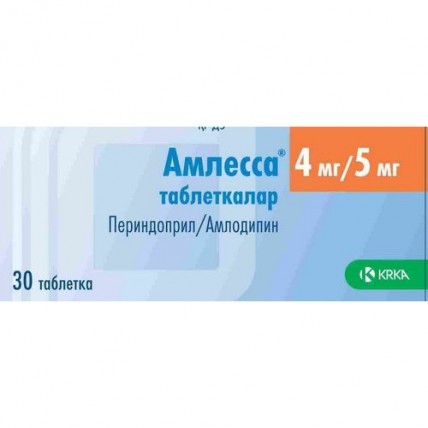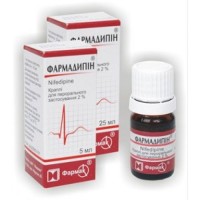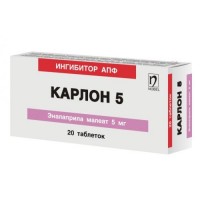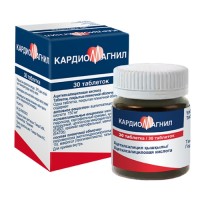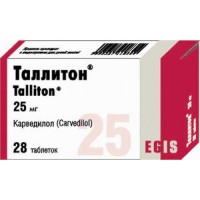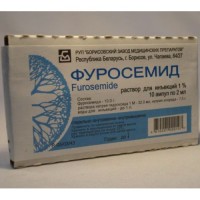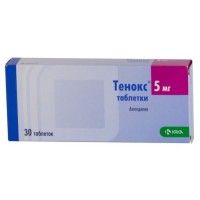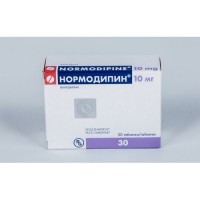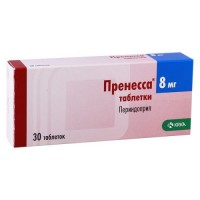The instruction for medical use
of AMLESSA® medicine
Trade name
АМЛЕССА®
the International unlicensed name
Is not present
the Dosage form
of the Tablet of 4 mg / 5 mg, 4 mg / 10 mg, 8 mg / 5 mg, 8 mg / 10 mg
Structure
One tablet contains
active agents: tablets of 4 mg / 5 mg: a perindoprila erbumin 4 mg, an amlodipina besilat 6.935 mg (5 mg are equivalent to an amlodipin),
tablets of 4 mg / 10 mg: a perindoprila erbumin 4 mg, an amlodipina besilat 13.870 mg (10 mg are equivalent to an amlodipin),
tablets of 8 mg / 5 mg: a perindoprila erbumin 8 mg, an amlodipina besilat 6.935 mg (5 mg are equivalent to an amlodipin),
tablets of 8 mg / 10 mg: a perindoprila erbumin 8 mg, an amlodipina besilat 13.870 mg (10 mg are equivalent to an amlodipin),
excipients: microcrystalline cellulose, starch prezhelatinizirovanny, sodium of starch glikolit, Calcii chloridum, Natrii hydrocarbonas, silicon dioxide colloidal anhydrous, magnesium stearate,
the Description
of the Tablet of white or almost white color, round shape, slightly biconvex, with slanted edges (for a dosage of 4 mg / 5 mg)
Tablets of white or almost white color, a capsulovidny form, biconvex, with risky on one party (for a dosage of 4 mg / 10 mg)
Tablets of white or almost white color, round shape, biconvex, with slanted edges (for a dosage of 8 mg / 5 mg)
Tablets of white or almost white color, round shape, biconvex, with risky on one party and slanted edges (for a dosage of 8 mg / 10 mg)
Pharmacotherapeutic group
the Drugs influencing a system renin-angiotensin, AKF inhibitors in a combination with other drugs. AKF inhibitors in a combination with other blockers of slow calcium channels. Perindopril and amplodipin.
The ATX C09BB04 code
the Pharmacological
Pharmacokinetics Pharmacokinetic Indicators properties of a perindopril and amlodipin in structure of Amlessa® and at reception of the tablets containing one component differ slightly.
Perindopril
Pri intake absorption of a perindopril occurs quickly, the maximum concentration is reached within 1 hour. The half-life period of a perindopril in plasma is 1 hour
Perindopril is pro-medicine. 27% of the accepted dose of a perindopril come to a blood stream in the form of an active metabolite of the perindoprilat. Except the active perindoprilat in an organism five more inactive metabolites are formed. The maximum concentration of the perindoprilat in plasma is reached in 3-4 hours after administration of drug.
Meal reduces transformation of a perindopril in perindoprilat, and, therefore, its bioavailability therefore the perindopril erbumin is recommended to be accepted once a day, orally, in the morning before a breakfast. Communication between a dose of a perindopril and its exposure in plasma is linear.
The volume of distribution of the untied perindoprilat is about 0.2 l/kg. Linking of the perindoprilat with proteins of plasma makes 20%. Generally binding happens about the angiotensin-the converting enzyme (ACE), but depends on concentration of drug. Perindoprilat is allocated with urine, final elimination half-life of its free fraction makes about 17 hours that allows to reach an equilibrium state in 4 days.
Removal of the perindoprilat slows down at elderly patients and also at patients with a heart or renal failure. Therefore, usual medical observation has to include frequent monitoring of level of creatinine and potassium.
Pri dialysis clearance of the perindoprilat makes 70 ml/min. The kinetics of a perindopril changes at patients with cirrhosis: the hepatic clearance of an initial molecule slows down twice. However the number of the formed perindoprilat does not decrease therefore selection of a dosage is not required.
Amlodipin
Pri intake in therapeutic doses amlodipin is well soaked up, reaching the maximum concentration in blood in 6-12 hours after reception. The absolute bioavailability is 64-80%. The volume of distribution is equal to about 21 l/kg. Meal does not affect bioavailability of an amlodipin. About 97.5% of the circulating amlodipin are connected with proteins of plasma.
Final plasma elimination half-life makes 35-50 hours that corresponds to prescribing of drug once a day. Amlodipin is substantially metabolized in a liver before formation of inactive metabolites, 60% of the accepted dose are removed with urine, 10% in the form of not changed amlodipin.
Use for elderly patients
Time of achievement of the maximum concentration of an amlodipin in plasma are identical at elderly and young patients. At elderly patients the clearance of an amlodipin decreases that is followed by increase in AUC and T1/2.
The Recomendumy mode of dosing for elderly the same though increase in a dose has to is carried out with care.
Use for patients with a renal and liver failure
At patients with a renal failure and abnormal liver functions elimination half-life of an amlodipin slows down.
The pharmacodynamics
of Amlessa represents a combination of a perindopril of an erbumin - AKF inhibitor and the amlodipina-antagonist of calcium ions of dihydropyridinic group. The inhibition of AKF leads to decrease in angiotensin II in plasma that leads to increase in activity of renin in plasma and to decrease in discharge of Aldosteronum. AKF inhibition also leads to increase in activity of the circulating and local kallikrein-kinin system (and also to activization of a system of prostaglandin). It is possible that this mechanism promotes approach of hypotensive effect of AKF inhibitors and partially causes some of side effects (for example, cough).
Perindopril acts through the active metabolite perindoprilat. Other metabolites did not show ability to inhibit action of AKF.
Hypertensia
Perindopril works in arterial hypertension of any degree: weak, average and heavy, reduces systolic and diastolic arterial blood pressure both in a dorsal decubitus, and in a standing position.
Perindopril reduces resistance of peripheral vessels that leads to a lowering of arterial pressure. As a result, the peripheral blood stream increases, without influencing heart rate.
As a rule, the renal blood stream increases while the level of glomerular filtration usually remains without changes.
The maximum hypotensive activity is reached in 4-6 hours after reception of a single dose and remains within not less than 24 hours.
The lowering of arterial pressure comes quickly. At the patients susceptible to treatment, normalization of arterial blood pressure happens within a month and remains without emergence of a tachyphylaxis.
The termination of treatment is not followed by development of a withdrawal.
Perindopril reduces a hypertrophy of a left ventricle.
It is confirmed that perindoprit has vasodilating effect, improves elasticity of large arteries and reduces a ratio of a stream / gleam of small arteries.
Patients with a stable coronary artery disease
the Treatment of a perindopril of an erbumin of 8 mg (that is equivalent to 10 mg of a perindopril of arginine) at reception leads to absolute significant decrease in primary final point by 1.9% (decrease in relative risk by 20%) once a day.
At the patients who had a myocardial infarction and/or revascularization in the anamnesis, absolute decrease on primary final point reaches 2.2% that corresponds to the decrease in relative risk (DRR) for 22.4%, in comparison with placebo.
Amlodipin – the antagonist of calcium ions and a blocker of slow channels, blocks receipt of calcium ions through membranes in smooth muscle cells of a myocardium and vessels. The mechanism of antihypertensive action of an amlodipin is caused by the direct weakening effect on unstriated muscles of vessels. The exact mechanism of action of an amlodipin in stenocardia is not finalized, but amlodipin reduces ischemia in two ways:
1) expands peripheral arterioles and thus reduces the general peripheric resistance (afterload) for which overcoming the cardiac performance as heart rate remains stable is spent, reduction of load of heart leads to decrease in consumption of energy a myocardium and its oxygen requirements
2) expands the main coronary arteries and coronary arterioles, at the same time intake of oxygen in a myocardium at patients with vasospastic stenocardia (Printsmetal's stenocardia or alternative stenocardia) increases.
At patients with hypertensia the single daily dose of an amlodipin provides clinically significant lowering of arterial pressure for 24 hours as in a prone position, and standing.
At patients with stenocardia the single daily reception of an amlodipin increases the general time of performance of physical activity, delays approach of an attack of stenocardia and development of a depression of a segment of ST (on 1 mm) during its performance, reduces the frequency of attacks of stenocardia and consumption of Tabulettaes Nitroglycerini.
Amlodipin has no adverse impact on a metabolism and lipids of blood plasma and is suitable for treatment of the patients having bronchial asthma, diabetes and gout.
Indications
- essential hypertensia - stable coronary heart disease
the Route of administration and doses
For intake.
It is desirable to take one pill of the drug Amlessa® in the morning, before meal, once a day.
The fixed combination of doses is not suitable for initial therapy. If necessary, change of a dosage should be carried out by individual titration of a dose of a free combination of components.
Амлесса® it can be appointed to patients with KK ³ 60 ml/min. without dose adjustment, to patients with KK & lt, 60 ml/min. are recommended individual titration of a dose of separate components.
Between change of plasma concentration of an amlodipin and extent of disturbance of renal function there is no correlation communication.
The dosing mode for patients with a liver failure is not set. Therefore, when prescribing the drug Amlessa® it is necessary to be careful.
The side effects
Connected with amlodipiny
it is frequent (from ≥1/100 to & lt, 1/10)
- drowsiness, dizziness, a headache
- a cardiopalmus
- inflows
- abdominal pain, nausea
- swelled, peripheral swelled
- fatigue
Infrequently (from ≥1/1.000 to & lt, 1/100)
- an increase or weight reduction
- insomnia, changes of mood
- a tremor, a hypesthesia, paresthesia
- disorders of vision
- sonitus
- a faint
- hypotension (and the effects connected with hypotension), short wind
- rhinitis
- vomiting, dyspepsia, changes in an intestines vermicular movement, dryness in a mouth, disturbances of taste
- an alopecia, a purpura, decolouration of skin, the increased sweating,
an itching, rash
- an arthralgia, myalgia, muscular spasms
- a dorsodynia, a stethalgia, an asthenia, an indisposition
- urination disturbances, a night polyuria, urination increase
- impotence, a gynecomastia
Seldom (from ≥1/10.000 to & lt, 1/1.000)
- anginal pain
Very seldom (& lt, 1/10.000)
- a leukopenia/neutropenia, thrombocytopenia
- a Quincke's edema, allergic reaction: a small tortoiseshell
- a hyperglycemia
- increase in a tone of muscles of a wall of hollow body
- peripheral neuropathy
- a myocardial infarction, perhaps, caused by excessive hypotension in patients of group of high risk
- arrhythmia (including bradycardia, ventricular tachycardia and fibrillation of auricles)
- a vasculitis
- cough
- a hypertrophic ulitis
- pancreatitis, gastritis
- hepatitis, cholestatic jaundice
- an erythema (different types)
- Stephens-Johnson's syndrome (malignant exudative erythema)
- increase in level of liver enzymes: Nuclear heating plant, ACT (generally correspond to a cholestasia)
At reception of blockers of calcium channels was reported about isolated cases of an extrapyramidal syndrome.
Connected with perindoprily
it is frequent (from ≥1/100 to & lt, 1/10)
- dizziness, a headache
- paresthesia
- disorders of vision
- sonitus
- hypotension (and the effects connected with hypotension)
- short wind, cough
- an abdominal pain, nausea, vomiting, dyspepsia, a dysgeusia, diarrhea, a constipation
- an itching, rash
- muscular spasms
- an asthenia
Infrequently (from ≥1/1.000 to & lt, 1/100)
- allergic reaction: a small tortoiseshell
- changes of mood
- a sleep disorder
- a bronchospasm, dryness in a mouth
- a Quincke's disease of the face, extremities, lips, mucous membranes, language, a glottis and/or throat
- sweating
- disturbance of renal function
- impotence
Seldom (from ≥1/10.000 to & lt, 1/1.000)
- the increased content of bilirubin and liver enzymes in serum
Is very rare (& lt, 1/10.000)
- confusion of consciousness
- a leukopenia/neutropenia, an agranulocytosis or a pancytopenia, thrombocytopenia, hemolytic anemia at patients with congenital insufficiency of G-6PDH, decrease in hemoglobin and a hematocrit
- stenocardia
- a stroke, perhaps, caused by very big hypotension in patients of group of high risk
- rhinitis
- eosinophilic pneumonia
- pancreatitis
- hepatitis, cytolytic or cholestatic hepatitis
- an erythema
- an acute renal failure
It is unknown (it is impossible to estimate on the available data)
- a hypopotassemia
- a vasculitis
- the increased urea level at blood and creatinine in serum,
the Contraindication hyperpotassemia
- hypersensitivity to a perindopril (or
to the AKF any other inhibitor), to an amlodipin (or to any dihydropyridine)
or to any of excipients
- the Quincke's disease in the anamnesis connected with the previous treatment
by AKF inhibitors
- a hereditary or idiopathic Quincke's disease
- pregnancy and the period of a lactation
- heavy arterial hypotension
- shock, including cardiogenic shock
- obstruction of an output path of a left ventricle (for example, a heavy stenosis
of an aorta)
- hemodynamically unstable heart failure after an acute
myocardial infarction
Medicinal interactions
the Kaliysberegayushchy diuretics (such as Spironolactonum, Triamterenum or amiloride) which are not recommended to a combination Connected with perindoprily, potassium additives and kaliysoderzhashchy substitutes of salt can lead to substantial increase of level of potassium in blood serum. If the accompanying use of these drugs is shown because of the expressed hypopotassemia, then at their reception it is necessary to observe extra care and to carry out frequent monitoring of content of potassium in blood serum.
The combined intake of lithium and AKF inhibitors can lead to reversible increase in concentration of lithium in serum and toxicity (heavy neurotoxicity). But if the combined reception is necessary, then it is necessary to carry out careful monitoring of level of lithium in blood serum.
Estramustinum is raised by risk of emergence of undesirable effects of a perindopril, such as Quincke's disease (angiootek).
Combinations which demand extra care
At a concomitant use of AKF inhibitors with non-steroidal anti-inflammatory drugs (for example, with acetylsalicylic acid ³ 3 g/day and anti-inflammatory drugs, TsOG-2 inhibitors and non-selective NPVS) there can occur decrease in hypotensive effect. The accompanying intake of AKF and NPVS inhibitors can increase risk of deterioration in renal function, including a possible acute renal failure, increase in content of potassium in blood serum, especially at patients with already available impaired renal function. It is necessary to appoint the combined intake of these drugs with care, especially at elderly patients. It is necessary to monitor adequate hydration of an organism of patients. At the beginning of combination therapy and also periodically during therapy, it is necessary to carry out monitoring of renal function.
Prescribing of AKF inhibitors to the patients receiving antidiabetic drugs (insulin or hypoglycemic sulfonamides) can lead to strengthening of hypoglycemic effect. The hypoglycemia comes seldom (probably improvement of tolerance of glucose with the subsequent decrease in need for insulin).
Combinations which demand care
From the patients accepting diuretics especially patients with the lowered volume of the circulating blood and/or deficit have salts, after an initiation of treatment the excessive lowering of arterial pressure can be observed by AKF inhibitor. Diuretic cancellation, increase in volume of the circulating blood or intake of salt before an initiation of treatment and also purpose of low initial doses of a perindopril and their gradual increase reduce risk of developing hypotension.
Sympathomimetics can reduce hypotensive effect of AKF inhibitors.
Rare messages about nitritoidny reactions (the symptoms including face reddening, nausea, vomiting and hypotension) at the patients undergoing injection therapy by gold-bearing drugs arrived (aurotiomalat sodium) and the accompanying treatment by AKF inhibitors, including perindoprit.
The Combinations connected with amlodipiny demanding extra care
At simultaneous use of CYP3A4 inhibitor with erythromycin from young patients and diltiazem from elderly patients, respectively, concentration of an amlodipin in blood plasma increased by 22% and 50%, respectively. However, the clinical value of these results remains uncertain. It is possible that strong CYP3A4 inhibitors (for example, ketokonazol, itrakonazol, ritonavir) can increase concentration of an amlodipin in blood plasma more than diltiazem. Amlodipin with CYP3A4 inhibitors it is necessary to appoint with care.
Simultaneous use of the inductors CYP3A4 (rifampicin, the St. John's wort which is made a hole, anticonvulsants, i.e. carbamazepine, phenobarbital, Phenytoinum, fosfenitoin, Primidonum) can lead to decrease in plasma concentration of an amlodipin in connection with increase in hepatic metabolism of an amlodipin these inductors. At combination of an amlodipin it is necessary to be careful with the inductors CYP3A4, if necessary the dosage of an amlodipin can be adapted.
Combinations which should be considered
With the beta-blockers appointed in heart failure (bizoprolol, karvedilol, metoprolol) risk of developing hypotension, weakness of heart at patients with heart failure increases if it is a latentna or it is not controlled (addition of negative inotropic effect). Besides, the beta-blocker can reduce a sympathetic reflex in severe hemodynamic repercussion.
At monotherapy, amlodipin it is safely appointed with thiazide diuretics, beta-blockers, AKF inhibitors, nitrates of long action, nitrolitseriny for sublingual use, digoxin, warfarin, atorvastatiny, sildenafily, antacid drugs (aluminum hydroxide gel, magnesium hydroxide, simetikon), Cimetidinum, non-steroidal anti-inflammatory drugs, antibiotics and oral hypoglycemic drugs.
The special researches conducted with Cimetidinum, atorvastatiny digoxin, warfarin and cyclosporine, did not reveal change in their pharmacokinetics and in pharmacokinetics of an amlodipin.
Combinations which demand extra care
Baclofenum are strengthened by expressiveness of hypotensive effect. At combined use it is necessary to carry out monitoring of arterial blood pressure and renal function and also, if necessary - to adapt a dose of antihypertensive drug.
Combinations which demand care
the Alpha blockers (Prazozinum, alfuzozin, docsazozin, tamsulozin, terazozin) beta-blockers, vazodilatator, nitroglycerine and other nitrates, tricyclic antidepressants, antipsychotic, anesthetizing drugs, amifostin enhance hypotensive effect of an amlodipin and increase risk of developing orthostatic hypotension.
Corticosteroids, tetrakozaktid reduce hypotensive effect (the delay of salt and water caused by action of corticosteroids).
The special instructions
Connected with perindoprily
Are available rare messages about a Quincke's disease of the face, extremities, lips, mucous membranes, language, a glottis and/or throat for the patients undergoing treatment by AKF inhibitors, including perindoprit. In such cases the reception of Amlessa® should be stopped and carried out immediately necessary monitoring up to total disappearance of symptoms. Usually, in cases when swelled affected only a face and lips, it passed without any treatment, antihistaminic drugs helped to facilitate symptoms. The Quincke's disease which is followed by a laryngeal edema can lead to a lethal outcome. In a paraglossa, a glottis or a throat at which obstruction of airways is probable, it is necessary to give immediately first aid which can include prescribing of adrenaline and/or maintenance of free airways. The patient has to be under fixed medical observation before total and final disappearance of symptoms. The increased risk of approach of a Quincke's disease at intake of AKF inhibitor exists at the patients who had the Quincke's disease which is not connected with intake of AKF inhibitors. Rare messages about an intestinal angiootek at the patients accepting AKF inhibitors arrived. At these patients there came the abdominal pain (with nausea and vomiting or without them), in certain cases it was not preceded angiootek persons and S-1 levels of esterase were normal. The diagnosis of an angiootek was made by means of the procedures including a computer tomography, ultrasound or at surgery, symptoms stopped after the termination of intake of AKF inhibitor. Intestinal angiootek it has to be included in the differential diagnosis of the patients accepting AKF inhibitors with an abdominal pain.
In rare instances, at the patients undergoing procedures of an aferez of LDL
(lipoproteids of low density) by means of dextransulphatic absorption when prescribing AKF inhibitors cases of development of life-threatening anaphylactoid reactions were noted. It was possible to avoid these reactions by temporary cancellation of AKF inhibitor every time before carrying out an aferez.
At some patients receiving AKF inhibitors during the desensibilizing therapy (for example, gimenopterichesky poison), there came anaphylactoid reactions. These reactions managed to be avoided by temporary cancellation of AKF inhibitor, but they came in case of careless administration of drug again.
At the patients accepting AKF inhibitors the neutropenia/agranulocytosis, thrombocytopenia and anemia were noted. At patients with normal function of a liver and lack of other complicating factors, the neutropenia comes seldom. At reception of a perindopril, patients should observe extreme care with kollagenozno-vascular diseases, to the patients undergoing immunodepressantny therapy, treatment by Allopyrinolum or procaineamide or those who has all these complicating factors, in particular, at already available renal failures. At some of such patients serious infections developed. In some cases intensive care by antibiotics was unsuccessful. When assigning a perindopril such patients are recommended to carry out periodic monitoring of calculation of leukocytes and to instruct patients about need to report about any symptoms of an infection (for example, sore throat, heat).
Precautions at reception
to Patients with the increased risk of approach of hypotension with clinical manifestations (with a reduced volume of the circulating blood: accepting diuretics, being on a diet with limited consumption of salt, on dialysis, having diarrhea or vomiting, at patients with heavy renin - dependent hypertensia) at treatment of Amlessa® it is necessary to carry out careful monitoring of arterial blood pressure, renal function and level of potassium in serum. Similar reasons are applicable also to patients with coronary heart disease and cerebrovascular diseases at which the profound lowering of arterial pressure can lead to a myocardial infarction or a stroke.
In case of development of hypotension, it is necessary to put the patient on a back and, if necessary, to fill the volume of the circulating blood by intravenous administration of 0.9% of solution of sodium chloride (9 mg/ml). Passing hypotension is not a contraindication for further administration of drug which can usually be continued surely after arterial blood pressure increased owing to increase in volume of the circulating blood again.
As well as other AKF inhibitors, perindoprit it is necessary to appoint with extra care to patients with a stenosis of the mitral valve and obstruction of an output path of a left ventricle, for example, with a stenosis of an aorta or a hypertrophic cardiomyopathy.
At therapy, AKF inhibitors noted cases of unproductive, ongoing cough which passes with drug withdrawal. The cough caused by intake of AKF inhibitor should be considered as a part of the differential diagnosis of cough.
At surgical intervention or during anesthesia the drugs causing hypotension, Amlessa® can block formation of angiotensin II, as a result of compensatory release of renin. It is recommended to stop treatment a day before operation. At approach of hypotension which is presumably connected with this mechanism of action it is necessary to increase the volume of the circulating blood.
At some patients undergoing treatment by AKF inhibitors, including perindoprily cases of the increased potassium content in blood serum were noted. Risk factors for development of a hyperpotassemia include a renal failure, deterioration in function of kidneys, age (& gt, 70 years), diabetes, the accidental phenomena, such as organism obezvozhennost, sharp warm decompensation, metabolic acidosis, concomitant use of kaliysberegayushchy diuretiki (Spironolactonum, eplerenon, Triamterenum or amiloride), potassium additives or kaliysoderzhashchy substitutes of salt and also intake of other medicines causing increase in level of potassium in serum (for example, heparin). Intake of potassium additives, kaliysberegayushchy diuretics and kaliysoderzhashchy substitutes of salt, especially patients with impaired renal function, can lead to the significant growth of level of potassium in serum. The hyperpotassemia can cause serezny, sometimes fatal, arrhythmia. If the accompanying purpose of a perindopril and the above-stated drugs is considered necessary, then their reception has to be carried out with care and at regular monitoring of content of potassium in blood serum.
The renal failure
In a renal failure (clearance of creatinine & lt, 60 ml/min.) is recommended individual titration of a dose of separate components. At patients with a renal failure the usual medical examination has to include monitoring of level of potassium and creatinine. At some patients with a bilateral renal arterial stenosis or a stenosis of an artery of the only kidney undergoing treatment by AKF inhibitors cases of increase in level of urea in blood and creatinine in serum which were reversible at the therapy termination were noted. It is the most probable at patients with a renal failure. In renovascular hypertensia there is also an increased risk of heavy hypotension and renal failure.
At some patients with hypertensia without visible disturbance of vessels of kidneys the increase in concentration of urea in blood and creatinine in serum was noted, usually it had insignificant and passing character, especially at the combined reception of a perindopril and diuretic. It is the most probable at the patients who already have a renal failure.
A liver failure
In rare instances intake of AKF inhibitors was followed by a syndrome which begins with cholestatic jaundice and progresses in fulminantny necrosis of a liver and (sometimes) comes to an end with a lethal outcome. The mechanism of this syndrome is still unclear. The patients receiving AKF inhibitors at which jaundice develops or considerably the level of enzymes of a liver increases, have to stop intake of APF inhibitor and undergo careful medical examination.
Patients with diabetes
the Patients with the diabetes taking the oral antidiabetic drugs or insulin within the first month of treatment by AKF inhibitor should carry out careful monitoring of a glycemia.
The race
the Quincke's disease at treatment by AKF inhibitors comes at patients of black race more often, than at patients of other races.
As well as at other AKF inhibitors, hypotensive it is effective
to Develop
of AMLESSA® medicine
Trade name
АМЛЕССА®
the International unlicensed name
Is not present
the Dosage form
of the Tablet of 4 mg / 5 mg, 4 mg / 10 mg, 8 mg / 5 mg, 8 mg / 10 mg
Structure
One tablet contains
active agents: tablets of 4 mg / 5 mg: a perindoprila erbumin 4 mg, an amlodipina besilat 6.935 mg (5 mg are equivalent to an amlodipin),
tablets of 4 mg / 10 mg: a perindoprila erbumin 4 mg, an amlodipina besilat 13.870 mg (10 mg are equivalent to an amlodipin),
tablets of 8 mg / 5 mg: a perindoprila erbumin 8 mg, an amlodipina besilat 6.935 mg (5 mg are equivalent to an amlodipin),
tablets of 8 mg / 10 mg: a perindoprila erbumin 8 mg, an amlodipina besilat 13.870 mg (10 mg are equivalent to an amlodipin),
excipients: microcrystalline cellulose, starch prezhelatinizirovanny, sodium of starch glikolit, Calcii chloridum, Natrii hydrocarbonas, silicon dioxide colloidal anhydrous, magnesium stearate,
the Description
of the Tablet of white or almost white color, round shape, slightly biconvex, with slanted edges (for a dosage of 4 mg / 5 mg)
Tablets of white or almost white color, a capsulovidny form, biconvex, with risky on one party (for a dosage of 4 mg / 10 mg)
Tablets of white or almost white color, round shape, biconvex, with slanted edges (for a dosage of 8 mg / 5 mg)
Tablets of white or almost white color, round shape, biconvex, with risky on one party and slanted edges (for a dosage of 8 mg / 10 mg)
Pharmacotherapeutic group
the Drugs influencing a system renin-angiotensin, AKF inhibitors in a combination with other drugs. AKF inhibitors in a combination with other blockers of slow calcium channels. Perindopril and amplodipin.
The ATX C09BB04 code
the Pharmacological
Pharmacokinetics Pharmacokinetic Indicators properties of a perindopril and amlodipin in structure of Amlessa® and at reception of the tablets containing one component differ slightly.
Perindopril
Pri intake absorption of a perindopril occurs quickly, the maximum concentration is reached within 1 hour. The half-life period of a perindopril in plasma is 1 hour
Perindopril is pro-medicine. 27% of the accepted dose of a perindopril come to a blood stream in the form of an active metabolite of the perindoprilat. Except the active perindoprilat in an organism five more inactive metabolites are formed. The maximum concentration of the perindoprilat in plasma is reached in 3-4 hours after administration of drug.
Meal reduces transformation of a perindopril in perindoprilat, and, therefore, its bioavailability therefore the perindopril erbumin is recommended to be accepted once a day, orally, in the morning before a breakfast. Communication between a dose of a perindopril and its exposure in plasma is linear.
The volume of distribution of the untied perindoprilat is about 0.2 l/kg. Linking of the perindoprilat with proteins of plasma makes 20%. Generally binding happens about the angiotensin-the converting enzyme (ACE), but depends on concentration of drug. Perindoprilat is allocated with urine, final elimination half-life of its free fraction makes about 17 hours that allows to reach an equilibrium state in 4 days.
Removal of the perindoprilat slows down at elderly patients and also at patients with a heart or renal failure. Therefore, usual medical observation has to include frequent monitoring of level of creatinine and potassium.
Pri dialysis clearance of the perindoprilat makes 70 ml/min. The kinetics of a perindopril changes at patients with cirrhosis: the hepatic clearance of an initial molecule slows down twice. However the number of the formed perindoprilat does not decrease therefore selection of a dosage is not required.
Amlodipin
Pri intake in therapeutic doses amlodipin is well soaked up, reaching the maximum concentration in blood in 6-12 hours after reception. The absolute bioavailability is 64-80%. The volume of distribution is equal to about 21 l/kg. Meal does not affect bioavailability of an amlodipin. About 97.5% of the circulating amlodipin are connected with proteins of plasma.
Final plasma elimination half-life makes 35-50 hours that corresponds to prescribing of drug once a day. Amlodipin is substantially metabolized in a liver before formation of inactive metabolites, 60% of the accepted dose are removed with urine, 10% in the form of not changed amlodipin.
Use for elderly patients
Time of achievement of the maximum concentration of an amlodipin in plasma are identical at elderly and young patients. At elderly patients the clearance of an amlodipin decreases that is followed by increase in AUC and T1/2.
The Recomendumy mode of dosing for elderly the same though increase in a dose has to is carried out with care.
Use for patients with a renal and liver failure
At patients with a renal failure and abnormal liver functions elimination half-life of an amlodipin slows down.
The pharmacodynamics
of Amlessa represents a combination of a perindopril of an erbumin - AKF inhibitor and the amlodipina-antagonist of calcium ions of dihydropyridinic group. The inhibition of AKF leads to decrease in angiotensin II in plasma that leads to increase in activity of renin in plasma and to decrease in discharge of Aldosteronum. AKF inhibition also leads to increase in activity of the circulating and local kallikrein-kinin system (and also to activization of a system of prostaglandin). It is possible that this mechanism promotes approach of hypotensive effect of AKF inhibitors and partially causes some of side effects (for example, cough).
Perindopril acts through the active metabolite perindoprilat. Other metabolites did not show ability to inhibit action of AKF.
Hypertensia
Perindopril works in arterial hypertension of any degree: weak, average and heavy, reduces systolic and diastolic arterial blood pressure both in a dorsal decubitus, and in a standing position.
Perindopril reduces resistance of peripheral vessels that leads to a lowering of arterial pressure. As a result, the peripheral blood stream increases, without influencing heart rate.
As a rule, the renal blood stream increases while the level of glomerular filtration usually remains without changes.
The maximum hypotensive activity is reached in 4-6 hours after reception of a single dose and remains within not less than 24 hours.
The lowering of arterial pressure comes quickly. At the patients susceptible to treatment, normalization of arterial blood pressure happens within a month and remains without emergence of a tachyphylaxis.
The termination of treatment is not followed by development of a withdrawal.
Perindopril reduces a hypertrophy of a left ventricle.
It is confirmed that perindoprit has vasodilating effect, improves elasticity of large arteries and reduces a ratio of a stream / gleam of small arteries.
Patients with a stable coronary artery disease
the Treatment of a perindopril of an erbumin of 8 mg (that is equivalent to 10 mg of a perindopril of arginine) at reception leads to absolute significant decrease in primary final point by 1.9% (decrease in relative risk by 20%) once a day.
At the patients who had a myocardial infarction and/or revascularization in the anamnesis, absolute decrease on primary final point reaches 2.2% that corresponds to the decrease in relative risk (DRR) for 22.4%, in comparison with placebo.
Amlodipin – the antagonist of calcium ions and a blocker of slow channels, blocks receipt of calcium ions through membranes in smooth muscle cells of a myocardium and vessels. The mechanism of antihypertensive action of an amlodipin is caused by the direct weakening effect on unstriated muscles of vessels. The exact mechanism of action of an amlodipin in stenocardia is not finalized, but amlodipin reduces ischemia in two ways:
1) expands peripheral arterioles and thus reduces the general peripheric resistance (afterload) for which overcoming the cardiac performance as heart rate remains stable is spent, reduction of load of heart leads to decrease in consumption of energy a myocardium and its oxygen requirements
2) expands the main coronary arteries and coronary arterioles, at the same time intake of oxygen in a myocardium at patients with vasospastic stenocardia (Printsmetal's stenocardia or alternative stenocardia) increases.
At patients with hypertensia the single daily dose of an amlodipin provides clinically significant lowering of arterial pressure for 24 hours as in a prone position, and standing.
At patients with stenocardia the single daily reception of an amlodipin increases the general time of performance of physical activity, delays approach of an attack of stenocardia and development of a depression of a segment of ST (on 1 mm) during its performance, reduces the frequency of attacks of stenocardia and consumption of Tabulettaes Nitroglycerini.
Amlodipin has no adverse impact on a metabolism and lipids of blood plasma and is suitable for treatment of the patients having bronchial asthma, diabetes and gout.
Indications
- essential hypertensia - stable coronary heart disease
the Route of administration and doses
For intake.
It is desirable to take one pill of the drug Amlessa® in the morning, before meal, once a day.
The fixed combination of doses is not suitable for initial therapy. If necessary, change of a dosage should be carried out by individual titration of a dose of a free combination of components.
Амлесса® it can be appointed to patients with KK ³ 60 ml/min. without dose adjustment, to patients with KK & lt, 60 ml/min. are recommended individual titration of a dose of separate components.
Between change of plasma concentration of an amlodipin and extent of disturbance of renal function there is no correlation communication.
The dosing mode for patients with a liver failure is not set. Therefore, when prescribing the drug Amlessa® it is necessary to be careful.
The side effects
Connected with amlodipiny
it is frequent (from ≥1/100 to & lt, 1/10)
- drowsiness, dizziness, a headache
- a cardiopalmus
- inflows
- abdominal pain, nausea
- swelled, peripheral swelled
- fatigue
Infrequently (from ≥1/1.000 to & lt, 1/100)
- an increase or weight reduction
- insomnia, changes of mood
- a tremor, a hypesthesia, paresthesia
- disorders of vision
- sonitus
- a faint
- hypotension (and the effects connected with hypotension), short wind
- rhinitis
- vomiting, dyspepsia, changes in an intestines vermicular movement, dryness in a mouth, disturbances of taste
- an alopecia, a purpura, decolouration of skin, the increased sweating,
an itching, rash
- an arthralgia, myalgia, muscular spasms
- a dorsodynia, a stethalgia, an asthenia, an indisposition
- urination disturbances, a night polyuria, urination increase
- impotence, a gynecomastia
Seldom (from ≥1/10.000 to & lt, 1/1.000)
- anginal pain
Very seldom (& lt, 1/10.000)
- a leukopenia/neutropenia, thrombocytopenia
- a Quincke's edema, allergic reaction: a small tortoiseshell
- a hyperglycemia
- increase in a tone of muscles of a wall of hollow body
- peripheral neuropathy
- a myocardial infarction, perhaps, caused by excessive hypotension in patients of group of high risk
- arrhythmia (including bradycardia, ventricular tachycardia and fibrillation of auricles)
- a vasculitis
- cough
- a hypertrophic ulitis
- pancreatitis, gastritis
- hepatitis, cholestatic jaundice
- an erythema (different types)
- Stephens-Johnson's syndrome (malignant exudative erythema)
- increase in level of liver enzymes: Nuclear heating plant, ACT (generally correspond to a cholestasia)
At reception of blockers of calcium channels was reported about isolated cases of an extrapyramidal syndrome.
Connected with perindoprily
it is frequent (from ≥1/100 to & lt, 1/10)
- dizziness, a headache
- paresthesia
- disorders of vision
- sonitus
- hypotension (and the effects connected with hypotension)
- short wind, cough
- an abdominal pain, nausea, vomiting, dyspepsia, a dysgeusia, diarrhea, a constipation
- an itching, rash
- muscular spasms
- an asthenia
Infrequently (from ≥1/1.000 to & lt, 1/100)
- allergic reaction: a small tortoiseshell
- changes of mood
- a sleep disorder
- a bronchospasm, dryness in a mouth
- a Quincke's disease of the face, extremities, lips, mucous membranes, language, a glottis and/or throat
- sweating
- disturbance of renal function
- impotence
Seldom (from ≥1/10.000 to & lt, 1/1.000)
- the increased content of bilirubin and liver enzymes in serum
Is very rare (& lt, 1/10.000)
- confusion of consciousness
- a leukopenia/neutropenia, an agranulocytosis or a pancytopenia, thrombocytopenia, hemolytic anemia at patients with congenital insufficiency of G-6PDH, decrease in hemoglobin and a hematocrit
- stenocardia
- a stroke, perhaps, caused by very big hypotension in patients of group of high risk
- rhinitis
- eosinophilic pneumonia
- pancreatitis
- hepatitis, cytolytic or cholestatic hepatitis
- an erythema
- an acute renal failure
It is unknown (it is impossible to estimate on the available data)
- a hypopotassemia
- a vasculitis
- the increased urea level at blood and creatinine in serum,
the Contraindication hyperpotassemia
- hypersensitivity to a perindopril (or
to the AKF any other inhibitor), to an amlodipin (or to any dihydropyridine)
or to any of excipients
- the Quincke's disease in the anamnesis connected with the previous treatment
by AKF inhibitors
- a hereditary or idiopathic Quincke's disease
- pregnancy and the period of a lactation
- heavy arterial hypotension
- shock, including cardiogenic shock
- obstruction of an output path of a left ventricle (for example, a heavy stenosis
of an aorta)
- hemodynamically unstable heart failure after an acute
myocardial infarction
Medicinal interactions
the Kaliysberegayushchy diuretics (such as Spironolactonum, Triamterenum or amiloride) which are not recommended to a combination Connected with perindoprily, potassium additives and kaliysoderzhashchy substitutes of salt can lead to substantial increase of level of potassium in blood serum. If the accompanying use of these drugs is shown because of the expressed hypopotassemia, then at their reception it is necessary to observe extra care and to carry out frequent monitoring of content of potassium in blood serum.
The combined intake of lithium and AKF inhibitors can lead to reversible increase in concentration of lithium in serum and toxicity (heavy neurotoxicity). But if the combined reception is necessary, then it is necessary to carry out careful monitoring of level of lithium in blood serum.
Estramustinum is raised by risk of emergence of undesirable effects of a perindopril, such as Quincke's disease (angiootek).
Combinations which demand extra care
At a concomitant use of AKF inhibitors with non-steroidal anti-inflammatory drugs (for example, with acetylsalicylic acid ³ 3 g/day and anti-inflammatory drugs, TsOG-2 inhibitors and non-selective NPVS) there can occur decrease in hypotensive effect. The accompanying intake of AKF and NPVS inhibitors can increase risk of deterioration in renal function, including a possible acute renal failure, increase in content of potassium in blood serum, especially at patients with already available impaired renal function. It is necessary to appoint the combined intake of these drugs with care, especially at elderly patients. It is necessary to monitor adequate hydration of an organism of patients. At the beginning of combination therapy and also periodically during therapy, it is necessary to carry out monitoring of renal function.
Prescribing of AKF inhibitors to the patients receiving antidiabetic drugs (insulin or hypoglycemic sulfonamides) can lead to strengthening of hypoglycemic effect. The hypoglycemia comes seldom (probably improvement of tolerance of glucose with the subsequent decrease in need for insulin).
Combinations which demand care
From the patients accepting diuretics especially patients with the lowered volume of the circulating blood and/or deficit have salts, after an initiation of treatment the excessive lowering of arterial pressure can be observed by AKF inhibitor. Diuretic cancellation, increase in volume of the circulating blood or intake of salt before an initiation of treatment and also purpose of low initial doses of a perindopril and their gradual increase reduce risk of developing hypotension.
Sympathomimetics can reduce hypotensive effect of AKF inhibitors.
Rare messages about nitritoidny reactions (the symptoms including face reddening, nausea, vomiting and hypotension) at the patients undergoing injection therapy by gold-bearing drugs arrived (aurotiomalat sodium) and the accompanying treatment by AKF inhibitors, including perindoprit.
The Combinations connected with amlodipiny demanding extra care
At simultaneous use of CYP3A4 inhibitor with erythromycin from young patients and diltiazem from elderly patients, respectively, concentration of an amlodipin in blood plasma increased by 22% and 50%, respectively. However, the clinical value of these results remains uncertain. It is possible that strong CYP3A4 inhibitors (for example, ketokonazol, itrakonazol, ritonavir) can increase concentration of an amlodipin in blood plasma more than diltiazem. Amlodipin with CYP3A4 inhibitors it is necessary to appoint with care.
Simultaneous use of the inductors CYP3A4 (rifampicin, the St. John's wort which is made a hole, anticonvulsants, i.e. carbamazepine, phenobarbital, Phenytoinum, fosfenitoin, Primidonum) can lead to decrease in plasma concentration of an amlodipin in connection with increase in hepatic metabolism of an amlodipin these inductors. At combination of an amlodipin it is necessary to be careful with the inductors CYP3A4, if necessary the dosage of an amlodipin can be adapted.
Combinations which should be considered
With the beta-blockers appointed in heart failure (bizoprolol, karvedilol, metoprolol) risk of developing hypotension, weakness of heart at patients with heart failure increases if it is a latentna or it is not controlled (addition of negative inotropic effect). Besides, the beta-blocker can reduce a sympathetic reflex in severe hemodynamic repercussion.
At monotherapy, amlodipin it is safely appointed with thiazide diuretics, beta-blockers, AKF inhibitors, nitrates of long action, nitrolitseriny for sublingual use, digoxin, warfarin, atorvastatiny, sildenafily, antacid drugs (aluminum hydroxide gel, magnesium hydroxide, simetikon), Cimetidinum, non-steroidal anti-inflammatory drugs, antibiotics and oral hypoglycemic drugs.
The special researches conducted with Cimetidinum, atorvastatiny digoxin, warfarin and cyclosporine, did not reveal change in their pharmacokinetics and in pharmacokinetics of an amlodipin.
Combinations which demand extra care
Baclofenum are strengthened by expressiveness of hypotensive effect. At combined use it is necessary to carry out monitoring of arterial blood pressure and renal function and also, if necessary - to adapt a dose of antihypertensive drug.
Combinations which demand care
the Alpha blockers (Prazozinum, alfuzozin, docsazozin, tamsulozin, terazozin) beta-blockers, vazodilatator, nitroglycerine and other nitrates, tricyclic antidepressants, antipsychotic, anesthetizing drugs, amifostin enhance hypotensive effect of an amlodipin and increase risk of developing orthostatic hypotension.
Corticosteroids, tetrakozaktid reduce hypotensive effect (the delay of salt and water caused by action of corticosteroids).
The special instructions
Connected with perindoprily
Are available rare messages about a Quincke's disease of the face, extremities, lips, mucous membranes, language, a glottis and/or throat for the patients undergoing treatment by AKF inhibitors, including perindoprit. In such cases the reception of Amlessa® should be stopped and carried out immediately necessary monitoring up to total disappearance of symptoms. Usually, in cases when swelled affected only a face and lips, it passed without any treatment, antihistaminic drugs helped to facilitate symptoms. The Quincke's disease which is followed by a laryngeal edema can lead to a lethal outcome. In a paraglossa, a glottis or a throat at which obstruction of airways is probable, it is necessary to give immediately first aid which can include prescribing of adrenaline and/or maintenance of free airways. The patient has to be under fixed medical observation before total and final disappearance of symptoms. The increased risk of approach of a Quincke's disease at intake of AKF inhibitor exists at the patients who had the Quincke's disease which is not connected with intake of AKF inhibitors. Rare messages about an intestinal angiootek at the patients accepting AKF inhibitors arrived. At these patients there came the abdominal pain (with nausea and vomiting or without them), in certain cases it was not preceded angiootek persons and S-1 levels of esterase were normal. The diagnosis of an angiootek was made by means of the procedures including a computer tomography, ultrasound or at surgery, symptoms stopped after the termination of intake of AKF inhibitor. Intestinal angiootek it has to be included in the differential diagnosis of the patients accepting AKF inhibitors with an abdominal pain.
In rare instances, at the patients undergoing procedures of an aferez of LDL
(lipoproteids of low density) by means of dextransulphatic absorption when prescribing AKF inhibitors cases of development of life-threatening anaphylactoid reactions were noted. It was possible to avoid these reactions by temporary cancellation of AKF inhibitor every time before carrying out an aferez.
At some patients receiving AKF inhibitors during the desensibilizing therapy (for example, gimenopterichesky poison), there came anaphylactoid reactions. These reactions managed to be avoided by temporary cancellation of AKF inhibitor, but they came in case of careless administration of drug again.
At the patients accepting AKF inhibitors the neutropenia/agranulocytosis, thrombocytopenia and anemia were noted. At patients with normal function of a liver and lack of other complicating factors, the neutropenia comes seldom. At reception of a perindopril, patients should observe extreme care with kollagenozno-vascular diseases, to the patients undergoing immunodepressantny therapy, treatment by Allopyrinolum or procaineamide or those who has all these complicating factors, in particular, at already available renal failures. At some of such patients serious infections developed. In some cases intensive care by antibiotics was unsuccessful. When assigning a perindopril such patients are recommended to carry out periodic monitoring of calculation of leukocytes and to instruct patients about need to report about any symptoms of an infection (for example, sore throat, heat).
Precautions at reception
to Patients with the increased risk of approach of hypotension with clinical manifestations (with a reduced volume of the circulating blood: accepting diuretics, being on a diet with limited consumption of salt, on dialysis, having diarrhea or vomiting, at patients with heavy renin - dependent hypertensia) at treatment of Amlessa® it is necessary to carry out careful monitoring of arterial blood pressure, renal function and level of potassium in serum. Similar reasons are applicable also to patients with coronary heart disease and cerebrovascular diseases at which the profound lowering of arterial pressure can lead to a myocardial infarction or a stroke.
In case of development of hypotension, it is necessary to put the patient on a back and, if necessary, to fill the volume of the circulating blood by intravenous administration of 0.9% of solution of sodium chloride (9 mg/ml). Passing hypotension is not a contraindication for further administration of drug which can usually be continued surely after arterial blood pressure increased owing to increase in volume of the circulating blood again.
As well as other AKF inhibitors, perindoprit it is necessary to appoint with extra care to patients with a stenosis of the mitral valve and obstruction of an output path of a left ventricle, for example, with a stenosis of an aorta or a hypertrophic cardiomyopathy.
At therapy, AKF inhibitors noted cases of unproductive, ongoing cough which passes with drug withdrawal. The cough caused by intake of AKF inhibitor should be considered as a part of the differential diagnosis of cough.
At surgical intervention or during anesthesia the drugs causing hypotension, Amlessa® can block formation of angiotensin II, as a result of compensatory release of renin. It is recommended to stop treatment a day before operation. At approach of hypotension which is presumably connected with this mechanism of action it is necessary to increase the volume of the circulating blood.
At some patients undergoing treatment by AKF inhibitors, including perindoprily cases of the increased potassium content in blood serum were noted. Risk factors for development of a hyperpotassemia include a renal failure, deterioration in function of kidneys, age (& gt, 70 years), diabetes, the accidental phenomena, such as organism obezvozhennost, sharp warm decompensation, metabolic acidosis, concomitant use of kaliysberegayushchy diuretiki (Spironolactonum, eplerenon, Triamterenum or amiloride), potassium additives or kaliysoderzhashchy substitutes of salt and also intake of other medicines causing increase in level of potassium in serum (for example, heparin). Intake of potassium additives, kaliysberegayushchy diuretics and kaliysoderzhashchy substitutes of salt, especially patients with impaired renal function, can lead to the significant growth of level of potassium in serum. The hyperpotassemia can cause serezny, sometimes fatal, arrhythmia. If the accompanying purpose of a perindopril and the above-stated drugs is considered necessary, then their reception has to be carried out with care and at regular monitoring of content of potassium in blood serum.
The renal failure
In a renal failure (clearance of creatinine & lt, 60 ml/min.) is recommended individual titration of a dose of separate components. At patients with a renal failure the usual medical examination has to include monitoring of level of potassium and creatinine. At some patients with a bilateral renal arterial stenosis or a stenosis of an artery of the only kidney undergoing treatment by AKF inhibitors cases of increase in level of urea in blood and creatinine in serum which were reversible at the therapy termination were noted. It is the most probable at patients with a renal failure. In renovascular hypertensia there is also an increased risk of heavy hypotension and renal failure.
At some patients with hypertensia without visible disturbance of vessels of kidneys the increase in concentration of urea in blood and creatinine in serum was noted, usually it had insignificant and passing character, especially at the combined reception of a perindopril and diuretic. It is the most probable at the patients who already have a renal failure.
A liver failure
In rare instances intake of AKF inhibitors was followed by a syndrome which begins with cholestatic jaundice and progresses in fulminantny necrosis of a liver and (sometimes) comes to an end with a lethal outcome. The mechanism of this syndrome is still unclear. The patients receiving AKF inhibitors at which jaundice develops or considerably the level of enzymes of a liver increases, have to stop intake of APF inhibitor and undergo careful medical examination.
Patients with diabetes
the Patients with the diabetes taking the oral antidiabetic drugs or insulin within the first month of treatment by AKF inhibitor should carry out careful monitoring of a glycemia.
The race
the Quincke's disease at treatment by AKF inhibitors comes at patients of black race more often, than at patients of other races.
As well as at other AKF inhibitors, hypotensive it is effective
to Develop
